B86 and NGC 6520
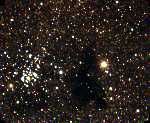 |
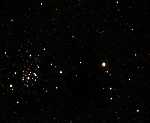 |
| Imax=20 | Imax=200 |
204 exposures, 10s each 9/17/09 Lake San Antonio, CA
The black patch at center is Barnard 86, a dark nebula in the Sagittarius Star Cloud near the center of the Milky Way. The star cluster to its left is NGC 6520.
Jupiter (with Io shadow)
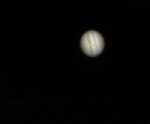 |
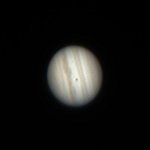 |
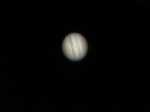 |
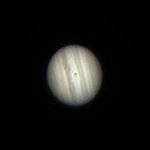 |
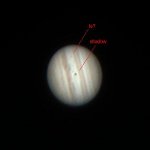 |
| Imax=450000 | deconvolved | Imax=450000 | deconvolved | labeled |
31 exposures, 0.02s each 9/17/09 Lake San Antonio, CA
When we turned the telescope to Jupiter we were fortunate to see Io's shadow crossing the planet. Io itself could also barely be made out. The seeing was good (compared with what we are used to around our apartment), and for much of the time we could see much more detail in Jupiter's clouds than appears in these images. The shadow of Io was also more distinct, quite black in the center. The degradation in the image is probably caused partly by the Barlow lens and partly by readout issues with the camera. Over the course of ~1 hour, we watched as first Io emerged from the left side of Jupiter, and then the shadow completed its transit.
NGC 281
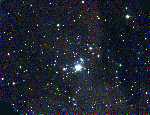 |
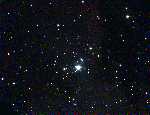 |
| Imax=10 | Imax=20 |
78 exposures, 10s each 9/17/09 Lake San Antonio, CA
Diffuse emission and dark nebula near η Cassiopeiae. Though faint, the nebulosity could at least be made out visually. This image could have been better but the telescope, left unattended, ran into a tripod leg partway through the exposure sequence.
Pleiades (Merope)
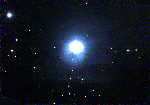 |
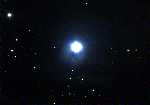 |
| Imax=20 | Imax=40 |
138 exposures, 10s each 9/17/09 Lake San Antonio, CA
This is an image of the region surrounding Merope, one of the brighter stars of the Pleiades cluster. The faint streaks resembling cirrus clouds are due to light from Merope reflected by dust. The circular feature near the star is an optical artifact, not part of the nebula.
NGC 6369 - "Little Ghost"
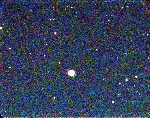 |
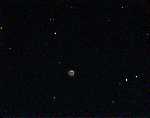 |
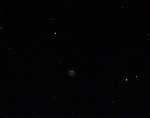 |
| Imax=5 | Imax=40 | Imax=100 |
72 exposures, 10s each 9/18/09 Lake San Antonio, CA
A small planetary nebula in Ophiuchus. I had never looked at this one before, and Kathy chose it from the Observer's Handbook. Small but distinct, not difficult to see visually. Some faint outer structure is visible in the leftmost image.
M20 - Trifid Nebula
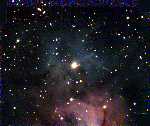 |
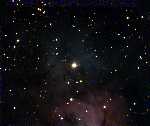 |
| Imax=15 | Imax=30 |
175 exposures, 10s each 9/18/09 Lake San Antonio, CA
This is again the Trifid nebula, but now centered on the reflective portion. The emissive portion can be seen at the bottom, and partly overlaps with the image from last year.
NGC 7293 - Helix Nebula
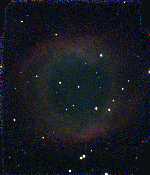 |
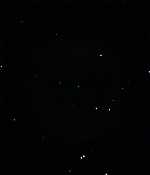 |
| Imax=10 | Imax=100 |
209 exposures, 10s each 9/18/09 Lake San Antonio, CA
This object was unexpectedly difficult to photograph with my setup due to its large size and low surface brightness. We could see it visually but not easily. For the imaging, it was not possible to fit the entire ring into the camera field of view, so it was necessary to pan around during the course of the many 10s exposures. But the main problem here is the readout noise in the camera is limiting my ability to capture such faint objects. This is good motivation to get a guiding setup working, to allow longer exposures. The (very hot) central star has a distinct blue color as seen in the right-most image.
NGC 246
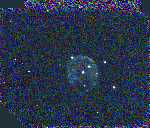 |
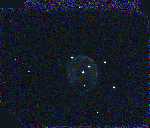 |
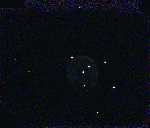 |
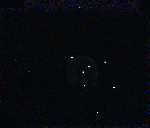 |
 |
| Imax=5 | Imax=10 | Imax=20 | Imax=30 | Imax=1000 |
142 exposures, 10s each 9/18/09 Lake San Antonio, CA
This is another planetary I had not seen before, in Cetus. It is faint but has interesting structure. The (very hot) central star has a distinct blue color, as seen in the right-most image.
M77
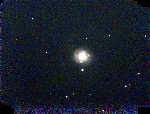 |
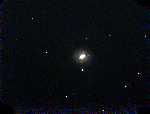 |
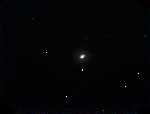 |
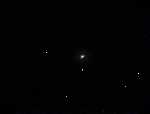 |
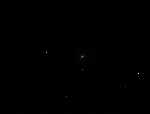 |
 |
| Imax=10 | Imax=25 | Imax=75 | Imax=150 | Imax=500 | Imax=1000 |
125 exposures, 10s each 9/18/09 Lake San Antonio, CA
A spiral galaxy in Cetus. It has a star-like nucleus as can be seen in the above sequence. This galaxy has some very faint outer structure that is barely hinted at in the image on the left.
NGC 6992 - Veil Nebula
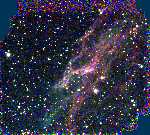 |
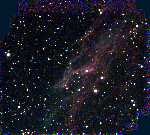 |
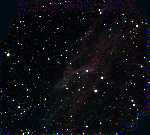 |
| Imax=5 | Imax=10 | Imax=20 |
182 exposures, 10s each 9/19/09 Lake San Antonio, CA
Another photo of a small part of the Eastern half of the Veil nebula. This is a much longer exposure sequence than we obtained last year, and the structure shows up much better.
NGC 6992 - Veil Nebula
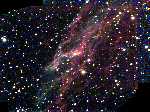 |
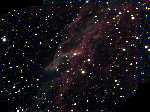 |
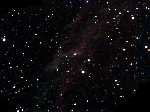 |
| Imax=5 | Imax=10 | Imax=20 |
83 exposures, 30s each 9/19/09 Lake San Antonio, CA
Same as above but using 30s exposures. Fainter details can be seen in the nebula, but the resolution is poorer due to tracking issues.
M76 - Little Dumbbell
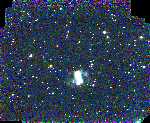 |
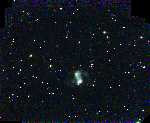 |
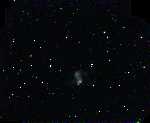 |
| Imax=5 | Imax=15 | Imax=40 |
131 exposures, 10s each 9/19/09 Lake San Antonio, CA
A planetary nebula in Persius. Although it is small, centeral bar structure could be seen visually fairly easily.
Mars
|
|
|
|
Pointing digital camera into eyepiece 2/14/10 Palo Alto, CA
These were taken a couple of weeks after the 2010 Mars opposition. This was not one of the better oppositions, and the apparent diameter on this day was expected to be only ~13.5 arcsec based on a table in the RASC Observer's Handbook. Nevertheless some features could be seen including a polar cap (near edge of circle at 10 o'clock) and some surface shading. The images here were taken by pointing a digital camera into the eyepiece (7mm eyepiece + 3X Barlow, camera zoomed in) with various exposure lengths. This was a frustrating way to take pictures since it is difficult to find the correct angle for pointing the camera, but the results shown here are somewhat representative of how Mars actually looked. During moments of clarity, somewhat sharper details could sometimes be seen.
Proper motion and Parallax
61 Cygni
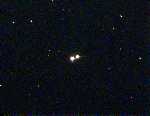 |
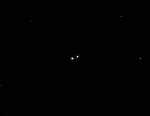 |
| Imax=200 | Imax=2000 |
55 exposures, 1s each 9/17/09 Lake San Antonio, CA
Updated photo of the nearby double star 61 Cygni, one of my targets for proper motion and parallax detection...
61 Cygni, 3X
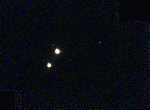 |
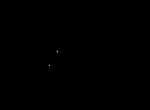 |
| Imax=200 | Imax=20000 |
118 exposures, 1s each 9/17/09 Lake San Antonio, CA
61 Cygni using 3X Barlow lens.
61 Cygni, 3X
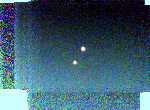 |
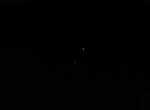 |
| Imax=500 | Imax=50000 |
252 exposures, 0.1s each 9/17/09 Lake San Antonio, CA
61 Cygni using 3X Barlow lens, shorter exposures.
Barnard's Star
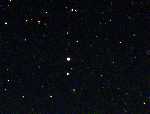 |
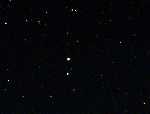 |
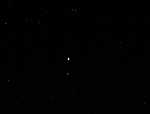 |
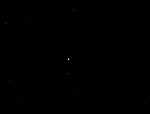 |
| Imax=50 | Imax=100 | Imax=500 | Imax=1000 |
24 exposures, 10s each 9/19/09 Lake San Antonio, CA
Updated photo of the Barnard's Star, a nearby red dwarf, one of my targets for proper motion and parallax detection. A quick comparison with last year's image suggests it has moved noticeably, but I have not had a chance to start this analysis yet...
Barnard's Star
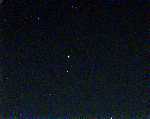 |
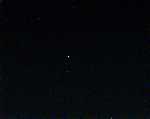 |
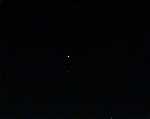 |
| Imax=200 | Imax=500 | Imax=1000 |
59 exposures, 1s each 9/19/09 Lake San Antonio, CA
Another Barnard's star image, shorter exposures to avoid saturation.
Barnard's Star, 3X
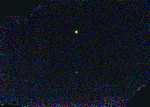 |
 |
| Imax=100 | Imax=500 |
169 exposures, 1s each 9/19/09 Lake San Antonio, CA
Barnard's star using 3X Barlow.